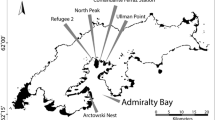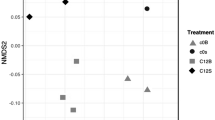Abstract
Burkholderia cenocepacia, Burkholderia ambifaria, and Burkholderia pyrrocinia are the Burkholderia cepacia complex (Bcc) species most frequently associated with roots of crop plants. To investigate the ecophysiological diversity of these species, metabolic profiling of maize rhizosphere isolates was carried out by means of the Biolog system, using GN2 and SFN2 plates and different parameters related to optical density (OD). The metabolic profiles produced by the SFN2 and GN2 plates were identical, but the SFN2's narrower range of OD values and significantly longer reaction times made these plates less suitable for differentiation of isolates. Principal component analysis of maximum OD (ODM) and maximum substrate oxidation rate (μM) data generated by GN2 plates allowed the selection of a reduced number of carbon sources. Statistical analysis of ODM values highlighted marked differences between the metabolic profiles of B. cenocepacia and B. ambifaria, whereas metabolic profiles of B. pyrrocinia clustered very often with those of B. cenocepacia. Analysis of the μM parameter resulted in a slightly lower differentiation among the three Bcc species and a higher metabolic diversity within the single species, in particular within B. cenocepacia. Finally, B. cenocepacia and B. pyrrocinia showed generally higher oxidation rates than B. ambifaria on those GN2 substrates that commonly occur in maize root exudates.




Similar content being viewed by others
References
J Balandreau V Viallard B Cournoyer T Coenye S Laevens P Vandamme (2001) ArticleTitleBurkholderia cepacia genomovar III is a common plant-associated bacterium Appl Environ Microbiol 67 982–985 Occurrence Handle10.1128/AEM.67.2.982-985.2001 Occurrence Handle1:CAS:528:DC%2BD3MXhtFSltbk%3D Occurrence Handle11157274
E Baudoin E Benizri A Guckert (2003) ArticleTitleImpact of artificial root exudates on the bacterial community structure in bulk soil and maize rhizosphere Soil Biol Biochem 35 1183–1192 Occurrence Handle10.1016/S0038-0717(03)00179-2 Occurrence Handle1:CAS:528:DC%2BD3sXlvVCmtLY%3D
A Bevivino C Dalmastri S Tabacchioni L Chiarini (2000) ArticleTitleEfficacy of Burkholderia cepacia MCI 7 on disease suppression and growth promotion of maize Biol Fertil Soils 31 225–231 Occurrence Handle10.1007/s003740050649
L Chiarini V Giovannelli A Bevivino C Dalmastri S Tabacchioni (2000) ArticleTitleDifferent portions of the maize root system host Burkholderia cepacia populations with different degrees of genetic polymorphism Environ Microbiol 2 111–118 Occurrence Handle10.1046/j.1462-2920.2000.00083.x Occurrence Handle1:STN:280:DC%2BD3M3jtlylsw%3D%3D Occurrence Handle11243257
T Coenye JJ LiPuma D Henry B Hoste K Vandemeulebroecke M Gillis DP Speert P Vandamme (2001) ArticleTitleBurkholderia cepacia genomovar VI, a new member of the Burkholderia cepacia complex isolated from cystic fibrosis patients Int J Syst Evol Microbiol 51 271–279 Occurrence Handle1:CAS:528:DC%2BD3MXivVOrtL4%3D Occurrence Handle11321071
T Coenye E Mahenthiralingam D Henry JJ LiPuma S Laevens M Gillis DP Speert P Vandamme (2001) ArticleTitleBurkholderia ambifaria sp. nov., a novel member of the Burkholderia cepacia complex comprising biocontrol and cystic fibrosis-related isolates Int J Syst Evol Microbiol 51 1481–1490 Occurrence Handle1:CAS:528:DC%2BD3MXmtVSlsro%3D Occurrence Handle11491349
T Coenye JJ LiPuma (2002) ArticleTitleMultilocus restriction typing: a novel tool for studying global epidemiology of Burkholderia cepacia genomovar III J Infect Dis 185 1454–1462 Occurrence Handle10.1086/340279 Occurrence Handle1:CAS:528:DC%2BD38XksVCjtbs%3D Occurrence Handle11992281
C Dalmastri L Chiarini C Cantale A Bevivino S Tabacchioni (1999) ArticleTitleSoil type and maize cultivar affect the genetic diversity of maize root-associated Burkholderia cepacia populations Microb Ecol 38 274–283 Occurrence Handle10.1007/s002489900177
C Dalmastri A Fiore C Alisi A Bevivino S Tabacchioni G Giuliano AR Sprocati L Segre E Mahenthiralingam L Chiarini P Vandamme (2003) ArticleTitleA rhizospheric Burkholderia cepacia complex population: genotypic and phenotypic diversity of Burkholderia cenocepacia and Burkholderia ambifaria FEMS Microbiol Ecol 46 179–187 Occurrence Handle1:CAS:528:DC%2BD3sXosFSltL4%3D
F Cello ParticleDi A Bevivino L Chiarini R Fani D Paffetti S Tabacchioni C Dalmastri (1997) ArticleTitleBiodiversity of a Burkholderia cepacia population isolated from maize rhizosphere at different plant growth stages Appl Environ Microbiol 63 4485–4493 Occurrence Handle9361434
A Fiore S Laevens A Bevivino C Dalmastri S Tabacchioni P Vandamme L Chiarini (2001) ArticleTitleBurkholderia cepacia complex: distribution of genomovars among isolates from the maize rhizosphere in Italy Environ Microbiol 3 137–143 Occurrence Handle10.1046/j.1462-2920.2001.00175.x Occurrence Handle1:STN:280:DC%2BD38%2Fgslynug%3D%3D Occurrence Handle11321544
BR Folsom PJ Chapman PH Pritchard (1990) ArticleTitlePhenol and trichloroethylene degradation by Pseudomonas cepacia G4: kinetics and interactions between substrates Appl Environ Microbiol 56 1279–1285 Occurrence Handle1:CAS:528:DyaK3cXktlOmt7w%3D Occurrence Handle2339883
JL Garland AL Mills JS Young (2001) ArticleTitleRelative effectiveness of kinetic analysis vs. single point readings for classifying environmental samples based on community-level physiological profiles (CLPP) Soil Biol Biochem 33 1059–1066 Occurrence Handle10.1016/S0038-0717(01)00011-6 Occurrence Handle1:CAS:528:DC%2BD3MXksVOru78%3D Occurrence Handle12194184
SJ Grayston CD Campbell (1996) ArticleTitleFunctional biodiversity of microbial communities in the rhizospheres of hybrid larch (Larix eurolepis) and Sitka spruce (Picea sitchensis) Tree Physiol 16 1031–1038 Occurrence Handle14871798
RI Griffiths AS Whiteley G O'Donnell MJ Bailey (2003) ArticleTitleInfluence of depth and sampling time on bacterial community structure in an upland grassland soil FEMS Microbiol Ecol 43 35–43 Occurrence Handle1:CAS:528:DC%2BD3sXhtVCqtrc%3D
KP Hebbar MH Martel T Heulin (1998) ArticleTitleSuppression of pre- and post-emergence damping-off in corn by Burkholderia cepacia Eur J Plant Pathol 104 29–36 Occurrence Handle10.1023/A:1008625511924
W Hitzl S Sharma A Rangger H Insam (1997) ArticleTitleSeparation power of the 95 substrates of the Biolog GN plates determined in various soils FEMS Microbiol Ecol 22 167–174 Occurrence Handle1:CAS:528:DyaK2sXhsFKktb0%3D
E Jaspers J Overmann (2004) ArticleTitleEcological significance of microdiversity: identical 16S rRNA gene sequences can be found in bacteria with highly divergent genomes and ecophysiologies Appl Environ Microbiol 70 4831–4839 Occurrence Handle10.1128/AEM.70.8.4831-4839.2004 Occurrence Handle1:CAS:528:DC%2BD2cXms1eksr4%3D Occurrence Handle15294821
I Kraffczyk G Trolldenier H Beringer (1984) ArticleTitleSoluble root exudates of maize: influence of potassium supply and rhizosphere microorganisms Soil Biol Biochem 16 315–322 Occurrence Handle10.1016/0038-0717(84)90025-7 Occurrence Handle1:CAS:528:DyaL2cXlvFSntLw%3D
P Lemanceau T Corberand L Gardan X Latour G Laguerre J-M Boeufgras C Alabouvette (1995) ArticleTitleEffect of two plant species, flax (Linum usitatissinum L.) and tomato (Lycopersicon esculentum Mill.), on the diversity of soilborne populations of fluorescent pseudomonads Appl Environ Microbiol 61 1004–1012 Occurrence Handle1:CAS:528:DyaK2MXktV2rsbk%3D
JE Lindstrom RP Barry (1998) ArticleTitleMicrobial community analysis: a kinetic approach to constructing potential C source utilization patterns Soil Biol Biochem 30 231–239 Occurrence Handle1:CAS:528:DyaK1cXnslGjtA%3D%3D
G Manno C Dalmastri S Tabacchioni P Vandamme R Lorini L Minicucci L Romano A Giannatasio L Chiarini A Bevivino (2004) ArticleTitleBurkholderia cepacia complex in an Italian cystic fibrosis centre: epidemiology and clinical course of patients infected with different Burkholderia cenocepacia strains J Clin Microbiol 42 1491–1497 Occurrence Handle10.1128/JCM.42.4.1491-1497.2004 Occurrence Handle15070994
BB McSpadden Gardener KL Schroeder SE Kalloger JM Raaijmakers LS Thomashow DM Weller (2000) ArticleTitleGenotypic and phenotypic diversity of phlD-containing Pseudomonas strains isolated from the rhizosphere of wheat Appl Environ Microbiol 66 1939–1946 Occurrence Handle10.1128/AEM.66.5.1939-1946.2000 Occurrence Handle1:STN:280:DC%2BD3c3ltVKgug%3D%3D Occurrence Handle10788364
JL Parke (1991) Root colonization by indigenous and introduced microorganisms DL Keister PB Cregan (Eds) The Rhizosphere and Plant Growth Kluwer Academic Publishers Dordrecht, The Netherlands 33–42
M Rougier (1984) ArticleTitleUltrastructural detection of fucosyl residues at the surface of axenically grown maize roots/sequential use of UeA lectin and fucosyl ferritin as the specific glycosylated marker Eur J Cell Biol 34 45–51 Occurrence Handle1:CAS:528:DyaL2cXltVOgtLo%3D Occurrence Handle6734630
DP Speert D Henry P Vandamme M Corey E Mahenthiralingam (2002) ArticleTitleEpidemiology of Burkholderia cepacia complex in patients with cystic fibrosis, Canada Emerg Infect Dis 8 181–187 Occurrence Handle11897071
P Vandamme B Holmes M Vancanneyet T Coenye B Hoste R Coopman H Reverts S Lauwers M Gillis K Kersters JRW Govan (1997) ArticleTitleOccurrence of multiple genomovars of Burkholderia cepacia in cystic fibrosis patients and proposal of Burkholderia multivorans sp. nov Int J Syst Bacteriol 47 1188–1200 Occurrence Handle1:STN:280:ByiH2sfgtFA%3D Occurrence Handle9336927
P Vandamme E Mahenthiralingam B Holmes T Coenye B Hoste P Vos ParticleDe D Henry DP Speert (2000) ArticleTitleIdentification and population structure of Burkholderia stabilis sp. nov. (formerly Burkholderia cepacia genomovar IV) J Clin Microbiol 38 1042–1047 Occurrence Handle1:CAS:528:DC%2BD3cXitVemu78%3D Occurrence Handle10698993
P Vandamme D Henry T Coenye S Nuzla M Vancanneyet JJ LiPuma DP Speert JRW Govan E Mahenthiralingam (2002) ArticleTitleBurkholderia anthina sp. nov. and Burkholderia pyrrocinia, two additional Burkholderia cepacia complex bacteria, may confound results of new molecular diagnostic tools FEMS Immunol Med Microbiol 33 143–149 Occurrence Handle1:CAS:528:DC%2BD38XktFygsrc%3D Occurrence Handle12052570
P Vandamme B Holmes T Coenye J Goris E Mahenthiralingam JJ LiPuma JRW Govan (2003) ArticleTitleBurkholderia cenocepacia sp. nov.—a new twist to an old story Res Microbiol 154 91–96 Occurrence Handle10.1016/S0923-2508(03)00026-3 Occurrence Handle12648723
L Vershuere V Fievez L Vooren ParticleVan W Verstraete (1997) ArticleTitleThe contribution of individual populations to the Biolog pattern of model microbial communities FEMS Microbiol Ecol 24 353–362
C Winstanley (2003) ArticleTitleImproved flagellin genotyping in the Burkholderia cepacia complex FEMS Microbiol Lett 229 9–14 Occurrence Handle10.1016/S0378-1097(03)00721-3 Occurrence Handle1:CAS:528:DC%2BD3sXptlOqsrc%3D Occurrence Handle14659536
MG Wise LJ Shimkets JV McArthur (1995) ArticleTitleGenetic structure of a lotic population of Burkholderia (Pseudomonas) cepacia Appl Environ Microbiol 61 1791–1798 Occurrence Handle1:CAS:528:DyaK2MXlsFyktrY%3D Occurrence Handle7646017
Author information
Authors and Affiliations
Corresponding author
Rights and permissions
About this article
Cite this article
Alisi, C., Lasinio, G.J., Dalmastri, C. et al. Metabolic Profiling of Burkholderia cenocepacia, Burkholderia ambifaria, and Burkholderia pyrrocinia Isolates from Maize Rhizosphere. Microb Ecol 50, 385–395 (2005). https://doi.org/10.1007/s00248-005-0223-y
Received:
Accepted:
Published:
Issue Date:
DOI: https://doi.org/10.1007/s00248-005-0223-y




